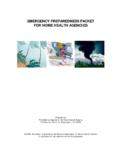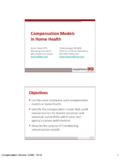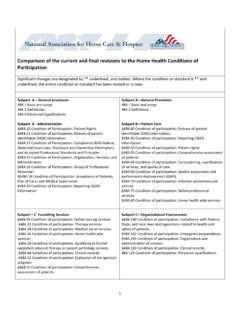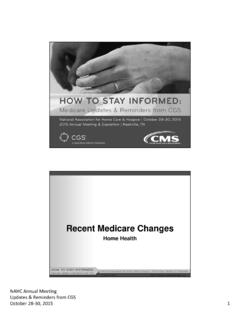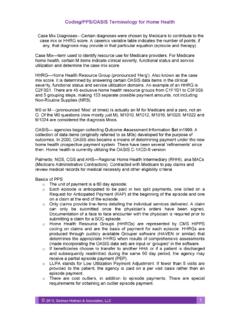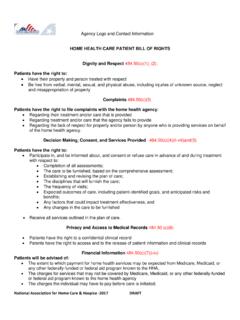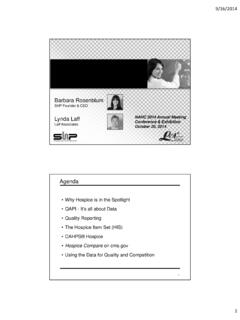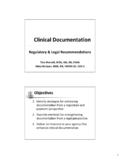Transcription of Crucial Accountability NAHC handout
1 1 Crucial Accountability : How to Hold Others Accountable for Violated Expectations, Broken Promises or Bad Behavior Presented by: Kevin R. Miller, President, VisionBound International and Beau Sorensen, COO, First Choice Home Health and Hospice When coworkers make promises do you sigh in relief or do you start biting your nails? Do you make plans, set goals, give assignments, and hope that maybe people will deliver? If you live in a culture of maybe where predictability, consistency, and integrity drop while your blood pressure rises, it s time to undergo rapid change and experience real results. Whether it s a broken promise, violated expectation, or just plain bad behavior, those who can hold others accountable help their organization thrive.
2 With Crucial Accountability skills you ll be able to deal with violated expectations early, discuss disappointments without encountering defensiveness, and solve Accountability problems without damaging the relationship. Focused Accountability is one of the few true magic bullets for your team s success. Never walk away from another touchy, controversial, or complex Accountability issue again. In this session we will review some of the basic skills outlined in the book Crucial Accountability (available in the NAHC bookstore) and deeply taught in the one or two day seminar by the same title (see ) Note that this book goes along with another best seller, Crucial Conversations, by the same authors.
3 What is Accountability ? Holding another person accountable, face to face, for broken promises, violated expectations or bad behavior. There is a gap between what is expected and what the person is doing. The end result is a change: who does what, by when and how do we follow up? Either the gap is closed or steps might be taken to free up their future. Why do we not hold others accountable? 1. A lack of skills. We don t know how to do it directly but safely 2. Fear: we are afraid of damaging the relationship, or of how they will react, or of our ability to handle a potential confrontation. But remember, if you don t talk it out you WILL act it out.
4 And acting it out is worse in the short and long run than addressing the issue head-on and solving it. 2 Crucial Accountability Break-Out handout A Crucial Accountability differs some from a Crucial conversation: it occurs when you need to safely hold someone accountable who has clearly violated an expectation, exhibited poor performance, or shown just plain bad behavior. These are some of the most difficult conversations that need to be held: but if you do not talk it out and solve it, you will surely act it out and make the problem worse. 1. What is a Crucial Accountability that you really need to hold with someone in your organization?
5 Think of a situation where someone has truly failed to meet your expectations or whose performance or behavior is holding your team back: _____ 2. How are you or others ACTING it out rather than talking it out and handling the needed confrontation? _____ 4. Think CPR! Is the problem with Content, Pattern or Relationships? _____ 5. Describe the Gap: In a clear statement, using facts NOT stories, exactly describe the gap between what is expected and what is being delivered: _____ 6. Make it Motivating: Look at the six sources of influence: How are Self, Others and Things impacting on either desire or ability?
6 What natural consequences can you help the others see are coming out of their behaviors? Use the tool on page four. _____ 7. Make it Easy: What can you do in the Self, Others and Things categories to make it easier for the person to close the gap and get their performance up to standard : _____ 8. What will you do if they or you start feeling unsafe in the discussion? _____ 9. Finally, Who, does What by When, and how will you follow up? when do you plan to hold this Crucial Accountability session? Make a commitment to yourself. Hint: read the book first if you can to prepare! _____ 3 Crucial Accountability Candidates With Whom About: (the GAP) C, P or R?
7 When? Desired Results 4 Unbundling the Gap: Six Sources of Influence Describe the Gap: Possible Lead Questions: Are you unable to do it or are you choosing not to do it? What happened? or What is causing this gap? Motivation (Desire) Ability Self/Personal 1 Helps: Hinders: Solution: Do you want to do it? or Do you feel motivated to do it? Do you like to do it? Self/Personal 2 Helps: Hinders: Solution: Are you able to do it?
8 Or Do you have the skills and ability to do it? Others/Social 3 Help: Hinder: Solution: Are others keeping you from wanting to do it? Others/Social 4 Help: Hinder: Solution: Are others keeping you from being able to do it? Things/Structure 5 Help: Hinder: Solution: Is something other than people frustrating you or hindering your desire to do it?(red-tape, etc?) Things/Structure 6 Help: Hinder: Solution: Is something other than people keeping you from being able to do it?
9 (Resources, structure, etc?) Note: After co-identifying solutions to the causes of the gap, don t forget to POP the question: If we (list the corrective actions) will you be able to meet the expectation as described? Only accept Yes and not I ll try, or Maybe. If they say one of those things, go back to the model and keep working through it until you find the other barriers. 5 Possible Next Steps: 1. Purchase and study the two books, Crucial Conversations and Crucial Accountability (on sale in the NAHC bookstore or online) 2. Visit the website at to view resources, watch video clips and register for an informative newsletter.
10 3. Use the worksheets provided in this packet to determine where Crucial Accountability sessions need to occur and decide when and how to hold them. Use the tools to diagnose and close the gap. 4. Contact us to have the full two day workshop delivered to your team. Email us at You may also contact one of us for some personal coaching or advice: or 5. Register to come aboard our Healthcare Leadership at Sea cruise to Mexico, Belize and Honduras in March 2015 where we will learn these and other critical leadership skills. See More information is at our booth here at NAHC.

